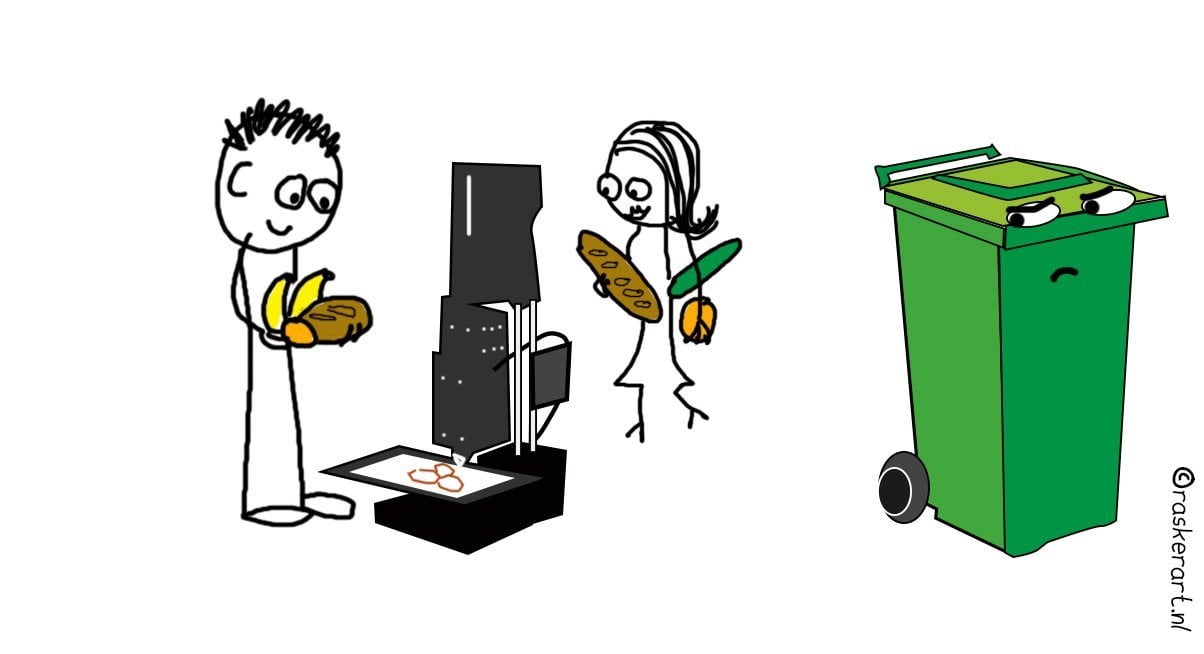
Houses, bridges and even organs. Using a 3D printer, you can make all of it. The market for 3D printing products and technologies will expand to over 22 billion euros by 2030. According to figures from the PWC consultancy firm, the next few years will see growth in aerospace, medical technology and the automotive industry in particular. However, in addition to these growth sectors, there is more to come: Designers who print costumes in 3D, or aircraft fanatics who rebuild a JSF to scale -you guessed it – 3D printed parts. And what’s this week’s best read? Cutting down on food waste by putting food leftovers into a 3D printer.
So what else is happening? And where is it all headed? Today we will take a crystal ball and together with Pieter Debrauwer, have a look at the possibilities this technique has to offer. Debrauwer is director of AMSYSTEMS, a partnership between Eindhoven University of Technology and TNO (Netherlands Organization for Applied Scientific Research), among others. This is where researchers develop 3D printers in collaboration with industry (food, pharmaceutical and high-tech).
You are able to print all kinds of materials, all sorts of plastic, metal, concrete, food and even living cells. Is there something a 3D printer can’t print?
“There are still some types of metal that are difficult to print. There is a lot of research on this. And hard polymers with a high degree of rigidity are difficult as well; these require a higher temperature. Different types of food vary in structure. When it comes to chocolate, you have to deal with coagulation properties. A few years ago it was only possible to print very small quantities of chocolate in order to avoid thermal problems. And now it is possible.”
And printing different types of materials together?
“Multi-material printing is a new area. There is a lot of experimentation on how to mix flexible materials with hard ones. Some polymers can be printed at 100 degrees Celsius. As for metal, sometimes up to 1000 degrees Celsius is required. These temperature variances are too high, you must let the metal cool down first. Ideally, you would have to be able to isolate the heat of the metal so that other materials will not be affected by it. However, no solution has been found as yet. Multi-material printing will become increasingly more important in the coming years, as you will be able to combine the properties of different materials.”
Which new developments are making you even more enthusiastic?
“In industry, manufacturers often use 3D printing methods when it concerns specific products in small print runs. Aircraft parts for a certain type of aircraft, for example. Because the quantities involved are low, you want these products to be perfect from the outset. But every product is different; at times it is quite difficult to estimate how material reacts to temperature levels. So it’s not always possible to print things properly in just one go. That’s why we use simulations and digital twins more and more. This enables you to eliminate design errors before you print something. You don’t need to make multiple prototypes of a product which you might only sell once.”
How fast will 3D printers become?
“3D printing will never be able to compete with mass production. At TNO, we made a printer that took 15 minutes to print one piece of pasta.It will take you forever to print a full plate with 25 of those pieces. We have begun to improve this and there are now about 30 pieces coming out at the same time of this printer within 1 minute and 40 seconds. But this still can’t compete with mass production.
However, speed is not the main thing. Components for satellites are also made with a 3D printer. A satellite doesn’t launch every day, so speed doesn’t factor into this. Quality and reliability play a crucial role here.
What is only possible with a 3D printer?
“Due to their layered output design, 3D printers can produce structures that cannot be made with a cast. You see this with implants, for example. To save weight, something that is normally solid can be left hollow. Another example: Turbine blades rotate very quickly which causes them to warm up. But because these blades are curved in a specific way, you cannot drill a straight hole into them. If you make a blade like that with a 3D printer, you are able to print an internal structure which acts as a cooling channel.
What will the future look like?
“I don’t think that the future will be bad at all if certain utilities in a house, like underfloor heating, were to be made by a 3D printer. Today, complete houses are already being churned out of a printer.
In the distant future, we will be able to precisely adapt the dose of a drug to each individual person. At the moment it is too expensive for pharmacists to set up a production line for specific medicines, because the disease is too rare or the medicines are too expensive. The dosage a patient receives is based on weight. Yet because the drug is only made in pills of 1000 mg, someone who only needs 800 mg then gets a higher dose. This might cause unpleasant side effects. What’s more, these drugs are so expensive and are taken by relatively few patients that a personalized dose is not only better for their health, but will ultimately reduce the cost of care as well.

